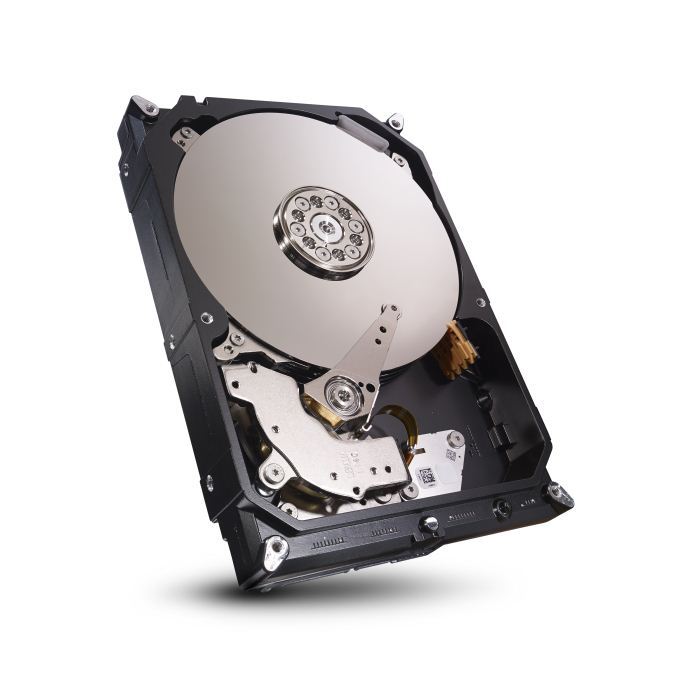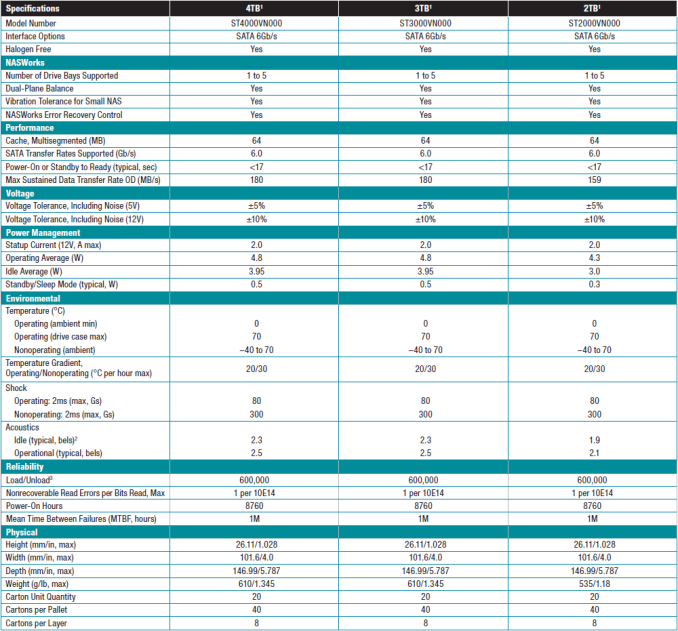Seagate Introduces NAS HDD: WD Red Gets a Competitor
by Ganesh T S on June 11, 2013 8:01 AM EST- Posted in
- NAS
- Storage
- Seagate
- Enterprise
Consumers looking to fill their SOHO / consumer NAS units with hard drives haven't had too many choices. Western Digital recognized early on that the dwindling HDD sales in the PC arena had to be made up for in the fast growing NAS segment. Towards this, they introduced the WD Red series (in 1TB, 2TB and 3TB capacities) last July. Today, Seagate is responding with their aptly named NAS HDD lineup. Just like the WD Red, these HDDs are targeted towards 1- to 5-bay NAS units. WD terms their firmware secret sauce as NASWare and Seagate's is NASWorks. NASWorks supports customized error recovery controls (TLER in other words), power management and vibration tolerance.
TLER helps to ensure that drives don't get dropped from the NAS and send the array into a rebuild phase. Seagate also claims that the firmware has an optimal balance for sequential and random performance.
Seagate does have a lead over WD in the capacity department. While the WD Red currently tops out at 3TB, Seagate's NAS HDD comes in 2 TB, 3 TB and 4 TB flavors. Seagate hasn't provided any information on the number of platters or spindle speed. Power consumption numbers are available, though. Average operating power is 4.3W for the 2TB model and 4.8W for the 3 TB and 4 TB ones.
Pricing is set at $126, $168 and $229 for the 2TB, 3TB and 4TB models respectively.
Update: Seagate has released an extensive product manual here. The 3TB and 4TB models have four platters each, while the 2TB model has two. The drives have a 3-year warranty.
Source: Seagate












46 Comments
View All Comments
mavere - Tuesday, June 11, 2013 - link
SPCR tested and concluded that WD's Red drives are the quietest, least vibration prone 3.5" drives available. As a plus, they consume less power and don't have the ridiculously aggressive and noisy headparking seen in 'green' drives.As someone whose speed needs are taken care of by SSDs and who is more than willing to buy 2.5" disk drives just for the silence & efficiency, I can't imagine getting a non-Red (or at least a drive that's been proven to be competitive).
Honestly, flash-based storage is good enough for most workloads nowadays, so I think it's time for disk drives to do something useful by being neither seen nor heard.
mercutiouk - Saturday, June 15, 2013 - link
The thing is. While TLER is "bad" in a raid there's another angle to consider with it. If a drive DOESN'T respond in a reasonable time - that's probably a drive with a bad block having trouble reading.Let's say another drive in the same array outright drops dead...
Come recovery time (using a raid 5 example here but it works with any raid method using a calculated parity and n-1 storage space) you try and rebuild the raid... that same bad block (hidden by the "NAS friendly" TLER setting) now means your array is toast.
mercutiouk - Saturday, June 15, 2013 - link
I've been using a bunch of spinpoint F3's in a raid-5 for about.... 3 years without any issues. Assuming most consumer drives have a "drive head parking" setting (which they do) or outright "spin down" idle settings there's no real reason why a regular drive should struggle to do 24/7.Gigaplex - Monday, August 12, 2013 - link
That's not how it's supposed to work. The TLER drive with the bad block will time out early, the RAID will detect this and try to repair it by writing the block again calculated from parity. If it's an isolated bad block the drive will remap the block to a good block. If it fails to write the block, the drive is then dropped.mrow - Tuesday, June 18, 2013 - link
Just an FYI, the next version of Unraid is going to include a feature that will allow you to use multiple disks/SSDs in a Btrfs "cache pool" which will provide for fault tolerance. Add two or three cheap laptop disks or SSDs and you'll get really high speed reads and writes that will also protect your data from disk failures before it's moved from the cache to the array.arthur449 - Tuesday, June 11, 2013 - link
The reason I don't buy/recommend Seagate drives in the last 5 years is because they 'fixed' the problems customers were having with drive reliability by cutting their product warranties down to 1 year from 3 - 5. They've recently bumped their warranties back up to 2 years on some drives.Let's hope Seagate differentiates these drives with a compelling price point, at least a 3 year warranty, and a solid launch backed up by positive reviews.
creed3020 - Tuesday, June 11, 2013 - link
Agreed, warranty is everything when it comes to mechanical disk drives. Kudos to Seagate for bringing something to the table to compete with the WD Reds. The pricing is competitive but I may just go for the 4TB 7200rpm Seagate regardless for my Synology NAS drive upgrade.Dentons - Tuesday, June 11, 2013 - link
Long drive warranties are just insurance policies. To buy a drive with double the warranty, you'll typically pay at least 50% more.Consider the cheapest drives you can buy, with 1 year warranties. By the time that drive fails, on average, you'll typical be able to buy a brand new drive more cheaply than had you bought a drive with a longer warranty.
Buy 10 drives today for $1500 ($150 ea) or buy 10 drives today for $1000 ($100 ea). The average failure period of these drives (when kept in a well ventilated, stationary enclosure with stable power) will be the same, and is typically quite long. It's hard to say for sure, but my anecdotal guess would be 3 to 5 years of constant use. Some will fail earlier, some very much later.
At least one will probably fail in the 1-year warranty period, and that will be covered. How many will fail in the 2 years following the warranty expiration? Two? Three? Even if it's that many, they'll probably cost $75 in 2 years, $50 in 3.
For most users, long warranties just don't make a lot of economic sense. As far as I can tell, these NAS drives are just the cheap commodity drives with slightly different firmware and an insurance policy. Unless you really need TLER, go with the cheaper drives.
joel4565 - Tuesday, June 11, 2013 - link
I have been using only WD for my spinning drives for the past few years. I have been lucky and haven't had a drive failure in several years with my Unraid box. The last drive I had fail was a Segate 320 GB drive several years ago.lurker22 - Tuesday, June 11, 2013 - link
Seagate is an instant pass. Decade ago they were great, then they purchase a slew of low quality HDD manufacturers (i.e. Maxtor) and their quality went through the toilet. All my seagates have had problems, not one problem with WD. As always your experience will vary,